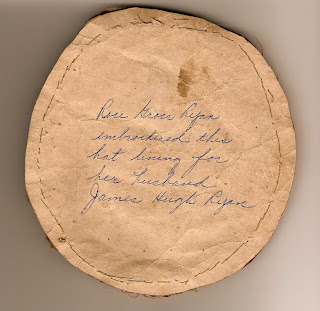 Raymond Mathew Ryan was the 9th of nine children born to James Hugh and Rose. He was born on August 3, 1904 and was baptized at St. Aloysius Church in Elmwood Place. His brother (and my grandfather), Roy, was four years older than Ray. But as Roy is in my direct line, I will discuss him last.
Raymond Mathew Ryan was the 9th of nine children born to James Hugh and Rose. He was born on August 3, 1904 and was baptized at St. Aloysius Church in Elmwood Place. His brother (and my grandfather), Roy, was four years older than Ray. But as Roy is in my direct line, I will discuss him last. Ray was only nine years old when his father died and seven when his older brother James died. His parents had already lost two children to scarlet fever. From a young age, Ray lived in a family where things were quite difficult financially.
Ray married Henrietta "Etta" Wulfekuhl on October 3, 1928. As newlyweds Ray's mother, Rose, continued to live with them in their home in Norwood. In the 1930 Census, Ray's occupation was listed as "paymaster for a paper company". As I understand it, life was not easy for Ray and his wife, Etta as they apparently lived in a few rooms on the second floor of a building with their three children. Over time, however, Ray and his wife achieved the middle class dream. Ray built a couple of homes and he and his wife had three beautiful children: Mary Agnes (who married Vincent DiBenedetto), Patricia Ann (who married Robert Beiderman), and James Hugh (who married Peg Hoffmann). The picture below includes Mary, Ray, Jim, Etta, and Patsy.

I hope to update this when I've had the opportunity to connect with Diane DiBenedeto, another family historian married to a descendant of Ray and Etta. My Aunt Evelyn remembers both with such fondness. She says that Etta was a truly joyful woman and one she admired greatly. Apparently she had a tremendous sense of humor and exuded a calm, self-confidence. Ray eventually worked as an "efficiency expert", working with factory workers to improve productivity. The picture below portrays a family that emerged from difficult times to achieve the "American Dream".

One of my favorite pictures was taken by Bill Batchelor, Jr. It includes three of the Ryan sisters (Rose, Florence and Bea) and their brother, Ray. The only thing that would have made the picture better for me would be if it included my grandfather, and their brother, Roy.
Here is a picture of Ray and Etta. What a handsome couple!







































